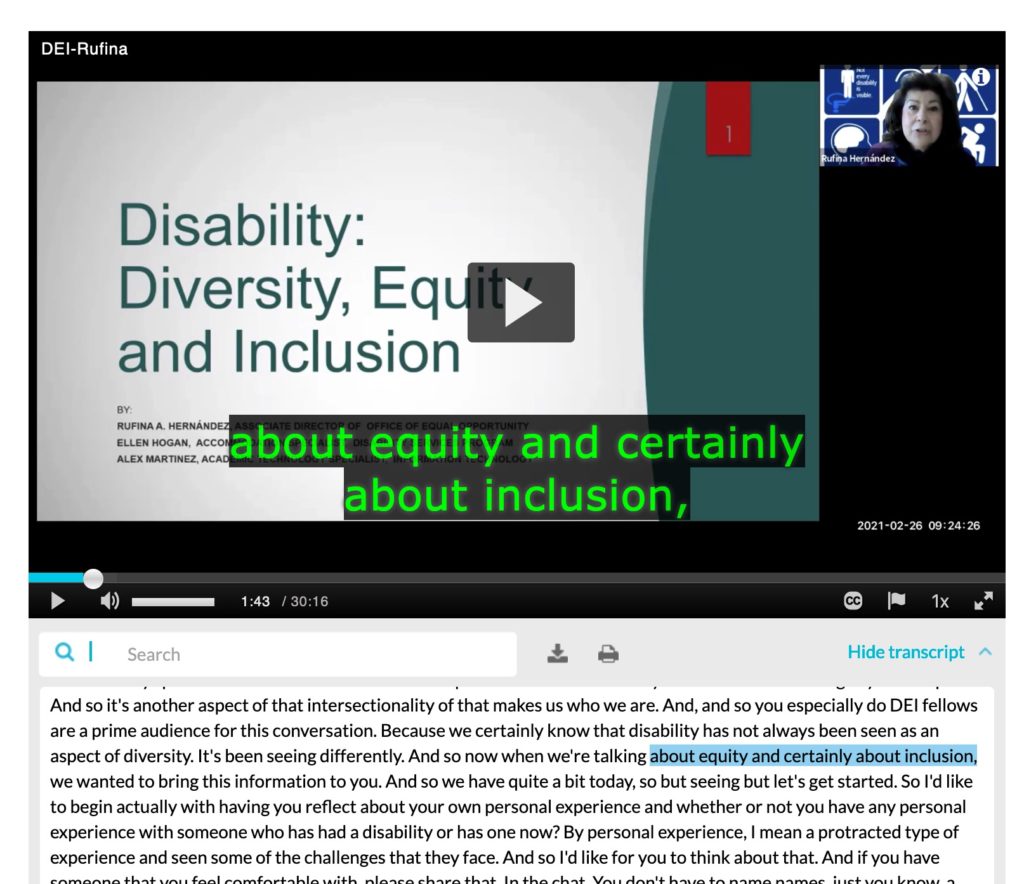Last updated on July 15, 2025
Our ZOOM enterprise license at the University of Denver now provides computer generated real-time closed captions and transcripts. This improves the accessibility and user experience for all ZOOM meeting/webinar participants. Here are a few tips for the various people participating in ZOOM events.
As the ZOOM host
Here are a few tips:
- Turn on ZOOM Live Transcript for everyone in the meeting/webinar.
- Inform the audience that Closed Captions & Live Transcript have been turned on but they are not 100% accurate.
- Inform the audience that live captions currently do not work within breakout rooms. Only the main ZOOM room supports closed captions.
- Closed captions are available on ZOOM iPhone and Android phones but live transcript is not.
If a human captioner is needed, contact The Office of Equal Opportunity and Title IX
As the ZOOM presenter
Here are a few tips:
- Always present with the assumption that a person in the audience has low vision, blindness, a learning disability (dyslexia, etc), hard of hearing, deaf or experience comorbidity (multiple disabilities).
- Make your presentation files available to your audience ahead of time so those with screen readers have a chance to review them prior to your presentation.
- Run Microsoft Word and PowerPoint accessibility checker before sending our your presentation slides.
- If the event has multiple speakers, each speaker should introduce themselves to help people with low vision or blindness identify speakers.
- Avoid talking over people, wait two seconds before each speaker, this will improve the transcript.
- Use a good quality microphone to improve caption quality.
- Describe your slides and read your text out loud. Reading your text will ensure that captions will be produced.
- If your slides include a lot of information, zoom-in to improve visibility. Consider converting your PowerPoint slides into a PDF in order to zoom-in.
- If you are showing a video, please have your video captioned in advance. If that’s not possible, make sure that “share computer sound” is turned on so that ZOOM live closed captions can work with the video narration.
- Avoid the use of the color red to convey messages. For those who are color blind, that may not be visible to them.
- Use strong contrasting colors with your slides.
- If there are images in your PowerPoint presentation and your sharing your slides with the audience later, please add “alt text” to each image.
- If you are using PowerPoint or Apple Keynote, show slides in a window and not full screen.
- Use the ZOOM annotation tools to point, circle or draw on your screen to improve attention and visibility of important content.
- Avoid describing a location in a Powerpoint slide by saying “over there”, “right here”, and instead say “at the top right” “the bottom left” etc.
As the ZOOM participant
Here are a few tips:
- Ask the Zoom host to send the presentation slides before the start of the meeting.
- Ask the ZOOM host to please turn on ZOOM closed captions.
- ZOOM closed captions font can be enlarged by selecting Video Settings -> Accessibility.
- ZOOM closed captions box can be moved around the screen to improve visibility.
- Under the CC button in ZOOM, click on Full Live Transcript to be able to review the full transcript.
As the video editor and publisher
Here are a few tips:
- If you are editing the recorded video, zoom-in to increase the slide visibility if the slide is difficult to view.
- Add additional large text or graphics to improve visibility and understanding.
- Improve audio quality if possible.
- Post your video to be shared on ZOOM, Kaltura DU MediaSpace or YouTube, all these players support accessibility keyboard controls.
- ZOOM, DU MediaSpace and YouTube support an interactive transcript. This feature allows users to scroll and search for text in the transcript.
- Remediate auto closed captions quality, make any corrections using the closed caption editor tools built with ZOOM, Kaltura DU MediaSpace or YouTube. Accuracy with captions should be 98+% or better.
- Add in speaker names and descriptive captions to help the audience know who is talking and what is happening.
- If you use a professional closed caption service, upload the .SRT or .VTT files to YouTube or Kaltura DU MediaSpace along with the video.
- Avoid Open Captions “burning-in” captions if your video is intended to be played on YouTube or Kaltura. Open Captions prevent user from controlling the size, color and font. It also prevent future caption editing.
- Open Captions is suggested if the video will be posted on a platform that does not support closed captions.
- After publishing, test the video on desktop and mobile devices.
- NOTE: The built-in Canvas video feature does not support auto closed captions but you can upload a .SRT or .VTT file.

Additional Resources
- How do I add captions to new or uploaded videos in the Rich Content Editor in Canvas as an instructor?
- ZOOM @ DU Closed captioning and live transcription
- ZOOM Support: Closed captioning and live transcription
- Kaltura @ DU Editing Closed Captions
- How Do You Make Video Accessible?
- W3C – Captions/Subtitles
